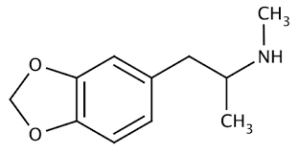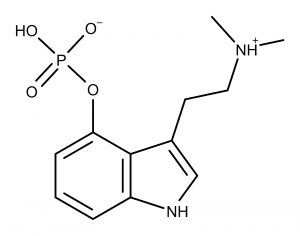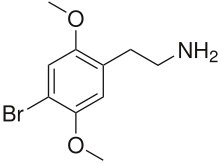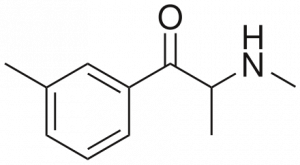MDMA

MDMA is an empathogen, ideal for clients with an intention to release trauma and unburden themselves, particularly those who are psychedelic naive. If your client presents with childhood trauma, sexual abuse, PTSD, anxiety, low self esteem, or a poor sense of self, MDMA is an excellent substance to start someone on. It is ideal for an emergence of the self and for resolving helping to resolve trauma. MDMA envelops the client in a warm, loving, euphoric, gentle, and safe cocoon that gives them space to work on issues that come up. MDMA floods the brain with serotonin, increases dopamine, endorphins, shuts down the amygdala and opens up the psyche. The Amygdala is the part of the brain that processes emotions, fear, freeze, fight or flight response and has an important role in processing traumatic memories. It is one of the most beautiful and gentlest medicines you will give anyone, although some trauma survivors may beg to disagree as it can open up flood gates of repressed memories and emotions. Even if you decide to use a different medicine for your client, MDMA is often a good option as a first medicine, then follow it with the second medicine.
IFS (Internal Family Systems) and inner child work are good companions for MDMA. If your client is ready, they can achieve a sense of calmness and experience themselves while they unburden their trauma. MDMA is a substance that will help heal their wounds by making them feel connected not only to themselves but to everyone. The more entrenched the trauma is, the more treatments may be indicated. Deep, intractable trauma may require several treatments to clear. Be mindful that the first treatment can unlock painful memories of trauma and worsen symptoms. MDMA always works no matter the mindset of the client. Be sure your client has been clear of SSRI’s for at least 6 weeks or MDMA will have a dulled effect. We typically use the same dosing protocol as MAPS: 125mg dose with a 75mg booster 90 minutes in. MDMA pairs well with cannabis, ketamine, mushrooms, 4ACO-DMT, and 2-CB
Active treatment time is between 4 and 5 hours. The half life of MDMA is about 7 hours.
Psilocybin

Psilocybin is the psychoactive ingredient in magic mushrooms. Psilocybin is also available in a purely chemical form which is used in clinical research. We use a few varieties of mushrooms depending on what the client is looking for. We find that mushrooms have an “entourage” effect which gives you a bigger experience than using psilocybin on its own. We use strains known as penis envy and golden teacher depending on the job we need to do. Mushrooms are ideal for those looking for a reset of their nervous system, those who want a mystical experience, looking to investigate other dimensions and entities, heal from depression, get reconnected with their body, or learn to trust in themselves/universe. They typically offer a more spiritual and somatic experience than MDMA by itself. We like to say that a mushroom journey will make you at least 10% more spiritual. Clients experiencing a mushroom journey often move around a lot, releasing stuck energy and emotions related to it. We also use mushrooms for “healthy normals” who are looking for a profound psychedelic experience.
The downside of using mushrooms is they can be disorienting, even in low doses or used with other substances. They can lead to strange dreams and metaphorical images that are difficult for most people to integrate. They may test your skills as an integration therapist. When psilocybin works well, it’s a beautiful experience and the client floats out of the treatment room when it’s over. Mushrooms, especially in high doses can promote feelings of nausea in some clients which is very uncomfortable while on the journey. Clients taking high doses of mushrooms are prone to vomiting so have your buckets ready. As psilocybin is a classic psychedelic, it is a non-specific amplifier it will amplify your client’s state of being, so if they are anxious, they will go straight into fear. It can produce very challenging experiences. Your clients can experience dark, fearful journey full of pain and sadness.
If your client is taking a high dose of psilocybin (4 – 5 grams) ensure they are very well-prepared for the nail-biting inter-dimensional roller coaster. It can be very intense. Never offer to treat highly anxious clients with psilocybin unless you know what you are doing and they at least have some experience with psychedelics. Rigid or controlling people may need a lot of body work and a high dose to take their default mode network offline. We have found that psilocybin isn’t always an effective substance for those with a rigid mindset as they seem to be able to fend off the medicine. We have had some success using 5gm of mushrooms and 20 – 40gm of 4-ACO-DMT.
Mushrooms contain chitin, which make up the cell walls of the mushroom. Like cellulose, chitin is difficult to digest, so have a bucket ready! For ceremonies or for longer journeys we mix mushrooms with cacao. The absorption of the material is slowed by the cacao offering a longer, gentler journey. Note that all substances are to be consumed on an empty stomach. This promotes faster absorption and prevents stomach distress.
A typical dose is 3 – 4 gm of a powdered mushroom in tea. Use more or less according the needs of your clients. Mushrooms can be combined with MDMA, cannabis, or 4-ACO-DMT. If a booster is indicated, we typically offer it 2 hours after the come up, or when the mushrooms have kicked in. We offer a booster of 20 mg of 4ACO-DMT or 75 mg of MDMA based on where the client is and what they are experiencing.
Active treatment time is between 4 and 5 hours. The half life of psilocybin is 3 hours.
See our recipes for palatable ways of ingesting mushrooms.
Psilocetin (4 ACO-DMT)

Psilocetin is a prodrug of psilocin; it is bioavailable and easily absorbed in the body with little processing by the body which makes it much more comfortable to consume than a high dose of powdered mushrooms. Use it when your client is prone to nausea as an alternative to mushrooms or in combination with other substances. Compounds in mushrooms have to be processed and absorbed in the stomach and liver before they become available to the body. There has an ongoing discussion about the similarities and differences between mushrooms and 4-ACO-DMT. Although the effects of 4-ACO-DMT are very similar to mushrooms there are some major differences. It creates a host of visual effects, there is a pronounced body high, and the messages your client receives are as sharp and as clear as they are on LSD.
David Nichols suggested 4-ACO-DMT use as an alternative to psilocybin for use in research. To give you some background, his paper in the Psychedelic Review describes some of the major differences between mushrooms and 4-ACO-DMT. 4-ACO-DMT has not yet been studied clinically so you are left to your own experiences and trip reports online for information. It is safe to use and is very similar to the psilocybin used in clinical trials. Another advantage of 4-ACO-DMT is that it can be easily ordered online as a research chemical and is typically 99% pure.
We use 4-ACO as a booster for mushroom treatments or on it’s own. A small subset of clients we treat refuse or cannot give up control even on 5 gm of mushrooms. If their default mode network doesn’t shut down, they will not have the full experience they need. As it can be unpleasant to consume 10 gm of mushrooms, we supplement mushrooms with a 4-ACO booster. The combination of these two substances appears to quiet the default mode network, allowing your “hard head” or controlling client to completely surrender to the experience.
Dosing of 4ACO is similar to 2C-B; a little goes a long way. Treatment doses vary from 5 mg to 40 mg, which is equivalent to 1 gm to 6 gms of mushrooms. 4-ACO is thought to be very safe although it has not been studied as much as the more common psychedelics like LSD, MDMA, or DMT. Anecdotal reports that very large doses (up to 250 mg) can be consumed without serious side effects. Stay well under 40mg and you’ll be safe. 4-ACO-DMT can be combined with mushrooms, MDMA, and cannabis.
Onset is 30 minutes and the effective treatment time is 5 to 8 hours. As with mushrooms, tell your client to expect the effects to linger for a few days. The half-life of 4ACo-DMT is thought to be similar to psilocybin.
2C-B

2C-B is a synthetic, Shulgin-discovered compound that has been likened to a combination of MDMA and LSD. It’s heart-opening, somatic, euphoric with more visuals than MDMA on its own. We use it to help our clients get into their bodies and go deeper into their emotions or explore their sexuality. We have found it to be much more effective than MDMA alone in helping clients to go deep into themselves and it can bring up some disturbing material. It has psychedelic properties, yet promotes a clarity of emotions that can be profound. It is also effective at opening up blocked sexual chakras. Like psilocybin, 2C-B can also give your client a physical and mental reset. Make sure your clients are ready for it. 2C-B can produce very challenging experiences, particularly on the somatic level. It is not advised for anyone with a lot of unresolved trauma. Stick with MDMA until most of it has cleared, the move on to 2C-B.
Therapists began using 2C-B in 1985 when MDMA became illegal and it was still legal. It was used as a substitute for MDMA and in combination with MDMA. In our protocol, we give clients 125 mg of MDMA and two hours later, 20 – 25 mg of 2C-B, which has a very gentle, euphoric opening, and often leads to a profound, body centred, emotional breakthrough. The reverse procol, 20 – 30mg of 2C-B then two hours later, 75mg MDMA, produces similar results but with a more subtle, euphoric ending. Using MDMA first is recommended for anxious clients.
In an interview, Shulgin describes 2C-B as…
“one of the most graceful, erotic, sensual, introspective compounds I have ever invented. For most people, it is a short-lived and comfortable psychedelic, with neither toxic side-effects nor next-day hang-over. Its effects are felt very much in the body, as well as in the mind, and thus it has found clinical use as a follow-up to MDMA. Once the MDMA has shown you where your problems are, the 2C-B opens up the emotional, intuitive and archetypal area of your psyche to help you solve them. It was probably one of my favorite drugs, back in those yesteryear days when one could explore one’s consciousness with legal immunity.”
An effective dose starts at 5 mg with a high dose being 40mg. It can have a slightly slower onset than other substances. Citrus in water can help lower onset time. Do not use grapefruit juice as it can prevent the breakdown of 2C-B in the liver and can prolong the journey. It can be used with MDMA, Ketamine, and psilocybin. Never use 2C-B with cannabis. It has been known to create psychosis-like experiences
Active treatment time is 3 – 4 hours.
The come down is very gradual and lingers for several hours after treatment.
The half-life of 2C-B is about 3 hours.
3-MMC
 3-Methylmethcathinone, abbreviated 3-MMC, is a short acting synthetic entactogen of the cathinone class with mild stimulant and empathogenic properties . The effects last from 4 – 5 hours and linger for hours
3-Methylmethcathinone, abbreviated 3-MMC, is a short acting synthetic entactogen of the cathinone class with mild stimulant and empathogenic properties . The effects last from 4 – 5 hours and linger for hours
Therapeutic Dose: 100mg to 150mg / Booster ~ 75 – 100mg oral consumption. Allow 35 – 45 minutes for it to take effect.
How does it work?
Classified as an entactogen/empathogen, 3MMC can feel mildly euphoric due to an increase in dopamine and norepinephrine. It calms the fear centres in the brain, and engenders a feeling of alert calmness. It also increases the salience of positive emotions, while increasing tolerance for negative emotions. The action of 3MMC inhibits shame and denial, making it possible to bring healing to deeply suppressed or hidden memories, regrets, etc. These effects are resourcing and bolster the therapeutic container, enhancing the ability to renegotiate challenging and traumatic material.
Is it addictive? Is it safe?
3MMC when used therapeutically under set dosage is very unlikely to cause addiction. Of the 117 participants in the MAPS-funded studies on MDMA-assisted psychotherapy for PTSD, no participants went on to develop MDMA substance use disorder. 3MMC has minimal withdrawal symptoms when used only occasionally.
There have been the occasional reports of people feeling anxious while under the effects of 3MMC. The drug itself is not known to cause anxiety and it has been surmised that the anxiety is the result of previously hidden or contained trauma coming to the surface. The unveiling of previously suppressed or buried trauma energy, feelings and memories is an important possibility to be aware of before embarking on a healing journey with this substance. If you do not have the resources or support needed, or do not feel prepared to open up and see suppressed traumatic content, then it would be wise to gather more support and resources first. Once excavated, it is possible that the “un-encapsulated trauma” can cause symptoms beyond the session; sometimes it can be difficult to re-contain what was opened up, creating the need for more therapy to resolve underlying layers. For example; if you experienced sexual abuse as a child it is very common to not remember it. It is common with 3MMC to open up the denial and amnesia surrounding the abuse and to thin the memory blocks. This can then impact your relationship with the abuser and can leave you feeling disturbed and shaken until resolved.
Although extremely rare, there is a very small possibility that one may have a profound awakening experience during the medicine journey. The awakening experience is usually characterized by a loss of ego and recognition that one is not who/what they thought they were. If the awakening experience is deep and profound it can leave a person with a loss or partial loss of their former personality.
This experience can sometimes take a few months to integrate, as the loss of personality can feel destabilizing and unusual. For people who are spiritually inclined, this loss of ego or personality is often the goal of spiritual practice.
There are some negative reports online about 3MMC, mostly written by people who have insufflated (snorted) or injected over 10 times the recommended dose. This substance works remarkably well when ingested orally, and there is no benefit with injection or insufflation.
What to expect?
The effects of 3MMC are very similar to MDMA. One nice part about this substance is that it has exceedingly minimal “hang over” effect, whereas MDMA can induce a “come down” effect that is usually experienced as feeling dazed and fatigued the following days and a depressed or anxious mood for up to 3 days following ingestion in some people. 3-MMC has been compared to a combination of MDMA and Cocaine. It brings very sharp and clear focus to any psychedelic experience.
Many will experience a highly productive session that involves a prolonged drug effect, sometimes up to 48 hours, as well as enhanced ability to continue resolving internal issues long after the co-therapy session has ended. As an entactogen/empathogen, the effects of 3MMC are much different from those of the “classical” psychedelics (psilocybin/LSD/peyote/DMT). It does not cause hallucinations or loss of control/agency.
People describe the effects in 3MMC in the following ways:
I felt more embodied
My thoughts quieted down
I was much more able to feel my body and was able to stay present with the uncomfortable and painful sensations that would normally send me reaching for pain meds and alcohol
“I felt more connected to my higher self and my inner healer just kept showing the next thing that I needed to see.”
“the medicine just kept working with me for almost 20 hours, wave after wave of stuck energy and discomfort. By the end I was exhausted. The next day after a good sleep I felt better than I have in years.”
“It reduced my shame so that I was able to share events from my life that I had never revealed to anyone ever before in my life. What a relief to finally not have to hold all of that by myself!”
“3MMC showed me a way of being and relating that has stayed with me. I just never knew it was possible to trust myself. I now know that the healing and wisdom I need is already inside myself…”
3MMC Effects:
Mood lift, Euphoria, enhanced dopamine hit Increased sociability and communication Music appreciation increased Mental sharpness and alertness Increased energy Positive feelings for self and others Increased honesty and openness Able to receive without judgement Less affected by fears or social conditioning Increased libido
Amphetamine-like side effects such as Increased blood pressure (about 10 – 15%) Bruxism and muscle tension Agitation amped up if present Speediness – talking, movements, mental agility Unslakable thirst Urinary retention Insomnia Decreased appetite
Mushrooms and MDMA
This is our go-to combination. We have found this combination to provide exceptional results. MDMA is euphoric, clear and heart-opening, while mushrooms connect you with your body and provides deep somatic healing. We typically use 100 mg of MDMA with around 3 grams of golden teacher mushrooms. Generally we time the doses so they kick in at the same time. MDMA takes about half an hour to kick in. Mushrooms in tea takes 15 – 20 minutes. Time accordingly. If we have an extremely anxious client, we will give them MDMA so it is fully expressed before we offer the mushrooms. The MDMA calms the system and allows your client to relax into their journey. Classic psychedelics like LSD, Mushrooms, or Mescaline are “non-specific amplifiers” in that they amplify the current state of the client. If the client’s mindset is anxious, the psychedelic will amplify it which can be very unpleasant. MDMA is perfect for calming the system, quieting the amygdala and launching them into a blissful state before the mushrooms take effect.
This combination opens up your psyche and connects you with your body which is a powerful way to release trauma. It is more likely to give your body a reset than using mushrooms alone. It is great for clearing out the clutter and unburdening yourself. If you want to really see what’s inside and clear it, this combination is the best. It even works well with hard heads as the two substances are difficult to fight off. MDMA provides clarity, loving attachment, euphoria, and a deep dive into the psyche. Mushrooms kick the healing up a few notches, taking you places MDMA can’t. The smaller dose of mushrooms does not cause nausea the way 5 gms will so there is less stomach distress with this stack.
Boosting is typically not necessary. If we do offer one, it is given 2 hours after the initial dose takes effect. It helps keep the client in the therapeutic zone longer so there is a greater opportunity for healing. We offer 75 – 100 mg of MDMA because finishing a treatment with MDMA is beautiful. If we feel the client needs to go deeper into the body and release, we offer 20 mg of 4-ACO-DMT.
Active treatment time is 4- 5 hours. The come down is very gradual and lingers for several hours after treatment.
We have put together a medicine and stacking chart that will prove valuable when working with clients. All of the stacks and sandwiches we use including dose and timing are on one chart.
https://drive.google.com/file/d/15Kk6lb3iPs0HKVcGO2eKm6bD1VO2ewH0/view?usp=sharing